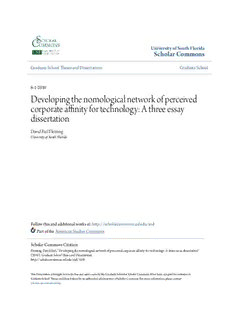
Developing the nomological network of perceived corporate affinity for technology: A three essay ... PDF
Preview Developing the nomological network of perceived corporate affinity for technology: A three essay ...
UUnniivveerrssiittyy ooff SSoouutthh FFlloorriiddaa SScchhoollaarr CCoommmmoonnss Graduate Theses and Dissertations Graduate School 12-7-2009 DDeevveellooppiinngg tthhee NNoommoollooggiiccaall NNeettwwoorrkk ooff PPeerrcceeiivveedd CCoorrppoorraattee AAffiffinniittyy ffoorr TTeecchhnnoollooggyy:: AA TThhrreeee EEssssaayy DDiisssseerrttaattiioonn David Earl Fleming University of South Florida Follow this and additional works at: https://scholarcommons.usf.edu/etd Part of the American Studies Commons SScchhoollaarr CCoommmmoonnss CCiittaattiioonn Fleming, David Earl, "Developing the Nomological Network of Perceived Corporate Affinity for Technology: A Three Essay Dissertation" (2009). Graduate Theses and Dissertations. https://scholarcommons.usf.edu/etd/1630 This Dissertation is brought to you for free and open access by the Graduate School at Scholar Commons. It has been accepted for inclusion in Graduate Theses and Dissertations by an authorized administrator of Scholar Commons. For more information, please contact [email protected]. Developing the Nomological Network of Perceived Corporate Affinity for Technology: A Three Essay Dissertation by David Earl Fleming A dissertation submitted in partial fulfillment of the requirements for the degree of Doctor of Philosophy Department of Marketing College of Business University of South Florida Major Professor: Paul Solomon, Ph.D. Andrew Artis, Ph.D. Richard Plank, Ph.D. Michael Coovert, Ph.D. Sajeev Varki, Ph.D. James Hensel, Ph.D. Date of Approval: December 7, 2009 Keywords: sales, services, technology, congruity, self-directed learning © Copyright 2010, David E. Fleming Dedication This dissertation is dedicated to my family. Without their support, none of this would have been possible. To my wife, Sarah, thank you for the sacrifices you have made and your patience throughout this journey. To my parents, I thank you for always being supportive and willing to do whatever you could to make this journey easier. Finally, this dissertation is dedicated to my children, Ryan and Rachael, for whose future all of this was done. Acknowledgments I am indebted to all of the people who had a hand in me getting through the Ph.D. process. I am thankful to Dr. Paul Solomon, my dissertation chair, for paving the way for me through the program so that I could attain my desired goals. I thank Dr. Andrew Artis for serving as a mentor and sounding board for the last seven years; your advice and feedback helped me avoid and overcome many obstacles. Also, I would like to acknowledge my original committee members, Dr. Richard Plank and Dr. Michael Coovert, for the effort and time they spent helping me complete this dissertation and whose expertise improved the quality of the research. I also want to thank Dr. Sajeev Varki and Dr. James Hensel for agreeing to serve on my dissertation committee when the need arose. I would like to acknowledge Wendy for making sure I always got everything in on time. Finally, I would like to thank Dr. Eric Harris for serving as a friend, mentor, and cheerleader, and for encouraging me to go beyond my comfort zone and get a Ph.D. Table of Contents List of Tables v List of Figures vi List of Appendices vii Abstract viii Chapter 1 1 Introduction 1 Research on Technology in Services and Sales 2 Personification of Firms 11 Importance of Perceived Attitudes 12 Employee Learning 13 Purpose 14 Research Questions 14 Theory 15 Contributions to Marketing 18 Academicians 18 Managers 20 Organization of Dissertation 22 References 24 i Chapter 2 How Managers Influence Employee Perceptions of the Firm 31 Introduction 31 Literature Review Communications Theory 33 Service Marketing 36 Technology Perceptions 38 Model Development 41 Methods 47 Sample 47 Measures 50 Analysis/Findings 50 Discussion 57 Implications 57 Academic 57 Managerial 59 References 61 Chapter 3 Employee Perceptions and Its Effect on Their Use of Self-Directed Learning 67 Introduction 67 Literature Review 69 Self-Directed Learning 69 Affinity for Technology 72 Model Development 74 Method 78 ii Sample 78 Measures 79 Analysis/Findings 80 Confirmatory Factor Analysis 80 Structural Equation Models 83 Nested Regression Models 87 Discussion 91 Contributions 93 Future Research 95 References 96 Chapter 4 The Effect of Customer Perceptions on Service Outcomes 102 Introduction 102 Literature Review 104 Personification of Firms 104 Individual Perceptions of Technology 105 Self-Congruity 109 Service Experience 110 Service Outcomes 112 Model Development 113 Methods 118 Sample 118 Measures 120 Analysis 121 iii Findings 123 Confirmatory Factor Analysis 123 Structural Equations Models 127 Parcel Models 130 Nested Regressions 132 Discussion/Limitations 134 Implications 136 Academic 136 Managerial 137 References 139 About the Author End Page iv List of Tables Table 1. Technology in the Services Literature 4 Table 2. Technology in the Sales Literature 8 Table 3. Customer Contact Employee Demographics 49 Table 4. Manager Demographics 49 Table 5. Confirmatory Factor Analysis Results 52 Table 6. Structural Equation Model Result 55 Table 7. Nested Regression Results 56 Table 8. Demographics 79 Table 9. Confirmatory Factor Analysis Results 82 Table 10. Structural Equation Model Results 85 Table 11. Nested Regression Results 90 Table12. Hypothesis Results 93 Table 13. Demographics 119 Table 14. Confirmatory Factor Analysis Results 126 Table 15. Structural Equation Model Results 129 Table 16. Parcel Model Results 132 Table 17. Nested Regression Findings 133 Table 18. Hypothesis Outcomes 135 v List of Figures Figure 1. Schramm Model of Communication 35 Figure 2. Conceptual Model 46 Figure 3. Hypothesized Model 47 Figure 4. Empirical Model 78 Figure 5. Conceptual Model 118 vi
Description: